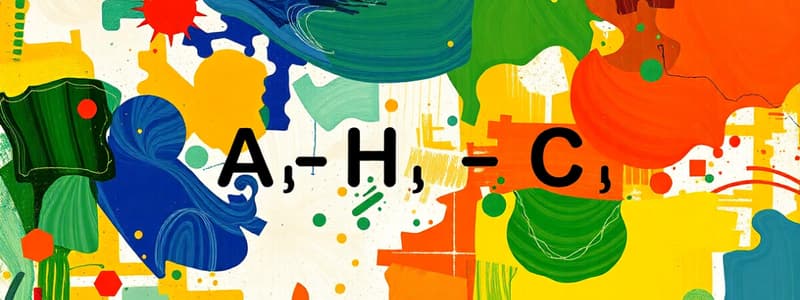Podcast
Questions and Answers
Which functional group is characterized by a carbonyl group (C=O) bonded to both an alkyl or aryl group and a hydroxyl group (-OH)?
Which functional group is characterized by a carbonyl group (C=O) bonded to both an alkyl or aryl group and a hydroxyl group (-OH)?
- Ester
- Ketone
- Aldehyde
- Carboxylic acid (correct)
In an elimination reaction, what is the primary change that occurs in the molecule?
In an elimination reaction, what is the primary change that occurs in the molecule?
- Atoms are reorganized within a molecule.
- One atom or group of atoms is replaced by another.
- Atoms or groups of atoms are removed to form a double or triple bond. (correct)
- Two or more molecules combine.
Which type of stereoisomer is defined as non-superimposable mirror images of each other?
Which type of stereoisomer is defined as non-superimposable mirror images of each other?
- Diastereomers
- Enantiomers (correct)
- Structural isomers
- Conformational isomers
What is the characteristic of a 'leaving group' in a reaction mechanism?
What is the characteristic of a 'leaving group' in a reaction mechanism?
Which conformation of cyclohexane is the most stable?
Which conformation of cyclohexane is the most stable?
What type of reaction is characteristic of alkenes?
What type of reaction is characteristic of alkenes?
Which of the following statements accurately describes a racemic mixture?
Which of the following statements accurately describes a racemic mixture?
What is the role of a nucleophile in a reaction mechanism?
What is the role of a nucleophile in a reaction mechanism?
Which functional group contains a nitrogen atom bonded to a carbonyl group?
Which functional group contains a nitrogen atom bonded to a carbonyl group?
What structural feature is required for a molecule to be chiral?
What structural feature is required for a molecule to be chiral?
In the Cahn-Ingold-Prelog (CIP) priority rules, what is the basis for assigning priority to atoms bonded to a chiral center?
In the Cahn-Ingold-Prelog (CIP) priority rules, what is the basis for assigning priority to atoms bonded to a chiral center?
What is the distinguishing characteristic of a meso compound?
What is the distinguishing characteristic of a meso compound?
Which type of isomers have the same connectivity of atoms but a different spatial arrangement?
Which type of isomers have the same connectivity of atoms but a different spatial arrangement?
What is the primary difference between a primary, secondary, and tertiary amine?
What is the primary difference between a primary, secondary, and tertiary amine?
What is the relationship between energy diagrams and reaction mechanisms?
What is the relationship between energy diagrams and reaction mechanisms?
Which of the following best describes the anti conformation in a Newman projection?
Which of the following best describes the anti conformation in a Newman projection?
What is the process of 'ring flipping' in cyclohexane primarily concerned with?
What is the process of 'ring flipping' in cyclohexane primarily concerned with?
The rotation of plane-polarized light is measured using a polarimeter. A compound that rotates plane-polarized light clockwise is called
The rotation of plane-polarized light is measured using a polarimeter. A compound that rotates plane-polarized light clockwise is called
What is the critical difference between structural isomers and stereoisomers?
What is the critical difference between structural isomers and stereoisomers?
Which statement is most accurate regarding reaction intermediates?
Which statement is most accurate regarding reaction intermediates?
Flashcards
Organic Chemistry
Organic Chemistry
Carbon-containing compounds and their properties. May contain H, N, O, halogens, P, Si, and S.
Functional Group
Functional Group
Specific atom group in a molecule responsible for characteristic chemical behavior.
Alkanes
Alkanes
Contain only C-C and C-H single bonds; generally unreactive.
Alkenes
Alkenes
Signup and view all the flashcards
Alkynes
Alkynes
Signup and view all the flashcards
Aromatic Rings
Aromatic Rings
Signup and view all the flashcards
Alcohols
Alcohols
Signup and view all the flashcards
Ethers
Ethers
Signup and view all the flashcards
Aldehydes
Aldehydes
Signup and view all the flashcards
Ketones
Ketones
Signup and view all the flashcards
Carboxylic Acids
Carboxylic Acids
Signup and view all the flashcards
Esters
Esters
Signup and view all the flashcards
Amines
Amines
Signup and view all the flashcards
Amides
Amides
Signup and view all the flashcards
Halides
Halides
Signup and view all the flashcards
Thiols
Thiols
Signup and view all the flashcards
Reaction Mechanism
Reaction Mechanism
Signup and view all the flashcards
Nucleophiles
Nucleophiles
Signup and view all the flashcards
Electrophiles
Electrophiles
Signup and view all the flashcards
Leaving Groups
Leaving Groups
Signup and view all the flashcards
Study Notes
- Organic chemistry is the study of the structure, properties, composition, reactions, and preparation of carbon-containing compounds, which may contain many other elements, including hydrogen, nitrogen, oxygen, halogens, phosphorus, silicon, and sulfur.
Functional Groups
- A functional group is a specific group of atoms within a molecule that is responsible for a characteristic chemical behavior of that molecule.
- Molecules can be classified based on their functional groups.
- Functional groups undergo the same types of chemical reactions regardless of the structure of the rest of the molecule.
- The following are common functional groups:
- Alkanes contain only C-C and C-H single bonds, and are generally unreactive.
- Alkenes have C=C double bonds and undergo addition reactions.
- Alkynes have C≡C triple bonds and also undergo addition reactions.
- Aromatic rings contain alternating single and double bonds in a cyclic structure, and undergo substitution reactions.
- Alcohols contain a hydroxyl group (-OH) bonded to a saturated carbon atom.
- Ethers contain an oxygen atom bonded to two alkyl or aryl groups (R-O-R').
- Aldehydes contain a carbonyl group (C=O) with at least one hydrogen atom attached to the carbonyl carbon.
- Ketones contain a carbonyl group (C=O) with two alkyl or aryl groups attached to the carbonyl carbon.
- Carboxylic acids contain a carboxyl group (-COOH).
- Esters contain a carbonyl group with an oxygen atom bonded to the carbonyl carbon and an alkyl or aryl group (R-COO-R').
- Amines contain a nitrogen atom bonded to one, two, or three alkyl or aryl groups, and are classified as primary, secondary, or tertiary amines, respectively.
- Amides contain a carbonyl group bonded to a nitrogen atom (R-CO-NR'R'').
- Halides contain a halogen atom (F, Cl, Br, I) bonded to an alkyl or aryl group.
- Thiols contain a sulfhydryl group (-SH) bonded to an alkyl or aryl group.
- Sulfides contain a sulfur atom bonded to two alkyl or aryl groups (R-S-R').
Reaction Mechanisms
- A reaction mechanism is a step-by-step sequence of elementary reactions by which overall chemical change occurs.
- Reaction mechanisms describe in detail exactly what takes place at each stage of a chemical reaction.
- Types of reaction mechanisms include:
- Addition reactions occur when two or more molecules combine to form a larger molecule.
- Elimination reactions involve the removal of atoms or groups of atoms from a molecule to form a double or triple bond.
- Substitution reactions involve the replacement of one atom or group of atoms with another atom or group of atoms.
- Rearrangement reactions involve the reorganization of atoms and bonds within a molecule.
- Key components of reaction mechanisms:
- Nucleophiles are electron-rich species that are attracted to electron-deficient centers (electrophiles).
- Electrophiles are electron-deficient species that are attracted to electron-rich centers (nucleophiles).
- Leaving groups are atoms or groups of atoms that depart from a molecule during a reaction, taking a pair of electrons with them.
- Carbocations are positively charged carbon atoms that are highly reactive intermediates.
- Carbanions are negatively charged carbon atoms that are also reactive intermediates.
- Radicals are species with unpaired electrons.
- Arrow pushing notation is used to illustrate the movement of electrons in a reaction mechanism. Arrows show the flow of electrons from a nucleophile to an electrophile or from a bond to an atom.
- Reaction intermediates are transient species that are formed during a multi-step reaction.
- Transition states are the highest energy point along the reaction pathway and represent the point at which bonds are breaking and forming.
- Energy diagrams illustrate the energy changes that occur during a reaction; they show the relative energies of reactants, products, intermediates, and transition states.
Stereochemistry
- Stereochemistry is the study of the three-dimensional structure of molecules.
- Isomers are molecules with the same molecular formula but different structural arrangements.
- Structural isomers have different connectivity of atoms.
- Stereoisomers have the same connectivity of atoms but different spatial arrangements.
- Enantiomers are stereoisomers that are non-superimposable mirror images of each other.
- Chiral molecules are molecules that are non-superimposable on their mirror images.
- A chiral center is an atom, usually carbon, that is bonded to four different groups.
- Diastereomers are stereoisomers that are not enantiomers.
- Meso compounds are molecules with chiral centers that are superimposable on their mirror images due to an internal plane of symmetry.
- Racemic mixtures contain equal amounts of both enantiomers and are optically inactive.
- Optical activity is the ability of a chiral molecule to rotate the plane of plane-polarized light.
- Dextrorotatory compounds rotate the plane of polarized light clockwise (+).
- Levorotatory compounds rotate the plane of polarized light counterclockwise (-).
- The Cahn-Ingold-Prelog (CIP) priority rules are used to assign priorities to the groups attached to a chiral center.
- R and S configurations are used to designate the absolute configuration of a chiral center based on the CIP priority rules.
- Conformational isomers (conformers) are isomers that can be interconverted by rotation around single bonds.
- Newman projections are used to visualize the different conformations of a molecule.
- Common conformations include:
- Eclipsed conformation where the bonds on adjacent atoms are aligned.
- Staggered conformation where the bonds on adjacent atoms are as far apart as possible.
- Gauche conformation where two large groups are adjacent to each other in a staggered conformation.
- Anti conformation where two large groups are 180 degrees apart in a staggered conformation.
- Cyclic compounds can also exhibit stereoisomerism; for example, cis and trans isomers of substituted cycloalkanes exist.
- Chair conformations are the most stable conformations of cyclohexane.
- Ring flipping in cyclohexane can interconvert axial and equatorial substituents.
Studying That Suits You
Use AI to generate personalized quizzes and flashcards to suit your learning preferences.




